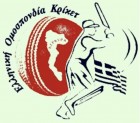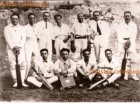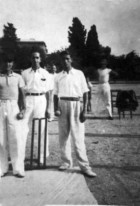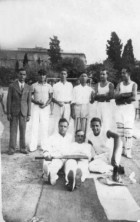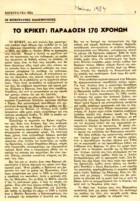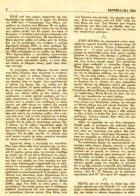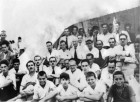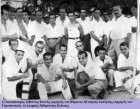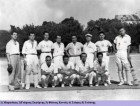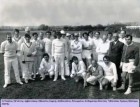Τα περισσότερα ντοκουμέντα του άρθρου προέρχονται από την
Ο Εμμανουήλ Μαυρογιάνης στο βιβλίο του Κερκυραϊκοί Τύποι και Κορφιάτικα έθιμα, του 1949, στις σελ.126/127/128
αναφέρει μεταξύ άλλων:
Tα Φορτιά ήτανε εκεί που τα παιδιά κάθε ηληκίας, από πέντε έως είκοσι και τριάντα ακόμα ετών άντρες εγυμναζόντανε στο ευγενικό παιγνίδι του Κρίκετ…..Εκτός από την επίσημη Κερκυραϊκή Εταιρία υπήρχαν δεκάδες άλλες μικρότερες……….Κάθε Σάββατο είχαμε στοιχήματα,όπως τα ελέγαμε. Εδιαλεγόνταν από ένδεκα και επαίζανε παιγνίδι τακτικό πλέον ο ένας όμιλος με τον άλλο ή με τους Εβραίους, οι οποίοι είχανε ιδιαίτερο σύλλογο με παίχτες εκλεκτούς…….Κάθε Κυριακή, επαίζανε το παιγνίδι το επίσημο,για το οποίο ενδιαφερόντανε όλη η Κέρκυρα, που από ενωρίς εμαζευόντανε στα Φορτιά για να εξασφαλίσει μια καλή θέση…….Όταν όμως έφθανε στην Κέρκυρα ο Αγγλικός Στόλος τότε εδιαλέγανε ένδεκα, τους αναγνωρισμένους καλλίτερους Κερκυραίους παίχτες για να αντιμετωπίσουνε άλλους τόσους διαλεχτούς Άγγλους Αξιωματικούς στην Πλατεία της Πόλεως.Εστήνανε από ενωρίς τις σκηνές, ετοιμάζανε όλα κι’ επαίζανε το παιγνίδι που παρακολουθούσε όλος ο τόπος με ενδιαφέρον και αγωνία.Οι Φιλαρμονικές της Πόλεως επαίζανε στα διαλήματα εκλεκτά κομμάτια…..
Η ΟΜΑΣ ΚΡΙΚΕΤ ΤΟΥ ΚΕΡΚΥΡΑΪΚΟΥ ΓΥΜΝΑΣΤΙΚΟΎ ΣΥΛΛΌΓΟΥ (1926-1928)
1)Κοσμάς Αναγνώστης Βιομήχανος (Χαρτοποι'ί'α Κοκίνη) 2)Γιάννης Παραμυθιώτης Φαρμακοποιός
3) Μιχαήλ Καμηλιέρης Αρωματοποιός 4) Γιάννης Μπατάς Δυνατός Boller αποκληθείς από τους Άγγλους Black Daimon
5) Ανδρέας Λουμπράνος Φοβερός Φερμαδόρος (έπαιζε χωρίς γάντια) Θυρωρός ΑΣΠΙΩΤΗ ΕΛΚΑ 6) Ιλαρίων Μπάκλης Βιομήχανος
7) Γιάννης Διαμαντής Υπάλληλος Τηλεγραφείου 8) Καρακαντάς 9)Σάββας Σκέμπρης Πολυνίκης Αθλημάτων Στίβου
10) Κων/νος Βούλγαρης Υποδηματοποιός παρανόμι Μπελεσκούντσιος 11) Νικόλαος Μακρης Μαθητής Γυμνασίου
Καρτ Ποστάλ επιχρωματισμένο αρχών του 20ου αιω.
Να τι έγγραφαν τα Κερκυραϊκά Νέα τον Ιούνιο του 1984
 Oi σκηνές (παυλιόνα) στήνονταν παλιά πρός το μέρος του Ανθώνα (Μποσκέτο)
Oi σκηνές (παυλιόνα) στήνονταν παλιά πρός το μέρος του Ανθώνα (Μποσκέτο)
Το Ιστορικό όπως αναφέρεται από την Ομοσπονδία
ΕΛΛΗΝΙΚΗ ΟΜΟΣΠΟΝΔΙΑ ΚΡΙΚΕΤ
ΣΥΝΤΟΜΟ ΙΣΤΟΡΙΚΟ
Το κρίκετ είναι ένα ήρεμο ομαδικό άθλημα, το οποίο χαρακτηρίζεται από τη σχεδόν τέλεια λειτουργικότητα, έκδηλη αρχοντιά στην εμφάνιση και στην εκτέλεση, φιλήσυχη εξέλιξη καθώς και από πραγματικό υψηλό αθλητικό πνεύμα. Είναι άθλημα χωρίς ακρότητες και κυριαρχείται από πειθάρχηση στις απαιτήσεις του αυστηρού κανονισμού του, μέσα σε μια πολιτισμένη ατμόσφαιρα παικτών και θεατών.
Το κρίκετ εμφανίζεται ιστορικά στην Ελλάδα για πρώτη φορά στην Κέρκυρα, η οποία βρισκόταν υπό αγγλική κατοχή, στις 23 Απριλίου 1823 με ένα παιχνίδι ανάμεσα στους αξιωματικούς του Βρετανικού Ναυτικού. Οι έφηβοι κερκυραίοι, ακόμη και οι ενήλικες της εποχής εκείνης, δελεάστηκαν από αυτό το ευγενικό και ήρεμο ψυχαγωγικό ομαδικό παιχνίδι και έδειξαν μεγάλο ενδιαφέρον για την εκμάθησή του και οι Άγγλοι από την πλευρά τους προθυμοποιήθηκαν με ευχαρίστηση να το διδάξουν και να το διαδώσουν. Από τη στιγμή αυτή και μετά χρειάστηκαν μόνο 12 χρόνια στους κερκυραίους για να μάθουν το παιχνίδι και να δημιουργήσουν δύο τοπικές ομάδες για να παίζουν με τους Βρετανούς. Η μία απαρτιζόταν από παίχτες κατώτερης και μέσης κοινωνικής στάθμης και ονομαζόταν μικροί και η άλλη από άτομα υψηλής κοινωνικής στάθμης και λεγόταν Μεγάλοι. Μετά την αποχώρηση των Άγγλων το 1864 από την Κέρκυρα και την ένωση των επτανήσων με την Ελλάδα, δημιουργήθηκαν δύο τοπικές ομάδες η Εταιρία Γκογκάκης και το σωματείο Καμπίτσης. Το 1893 λόγω έλλειψης παικτών τα δύο αυτά σωματεία συγχωνεύτηκαν και δημιούργησαν τον Κερκυραϊκό Γυμναστικό Σύλλογο (Κ.Γ.Σ.), το τρίτο αρχαιότερο σωματείο στην Ελλάδα μετά τον Πανελλήνιο και τον Πανιώνιο. Ο Κ.Γ.Σ. ήταν ο μοναδικός αντίπαλος για τις ομάδες των πλοίων του Βασιλικού Ναυτικού που επισκέπτονταν την Κέρκυρα. Το 1923 ιδρύθηκε ο Εργατικός και το 1925 άνοιξε τις πύλες του στην αριστοκρατία και ιδρύθηκε ο Γ.Σ.Κ. Βύρωνας, στη μνήμη του μεγάλου ποιητή. Αποκορύφωμα στην εποχή πριν από τον Ά Παγκόσμιο Πόλεμο ήταν το 1904 με 30-40 πλοία του Μεσογειακού στόλου να παρευρίσκονται στους αγώνες κρίκετ και το 1932 που ήταν παρούσα η πριγκίπισσα της Ουαλίας στο πολεμικό πλοίο Queen Elizabeth καθώς και 45 άλλα πλοία.
Το 1996 ιδρύθηκε στην Κέρκυρα η Ελληνική Ομοσπονδία Κρίκετ (ΕΛ.Ο.Κ.) η οποία με ειδικό νομοθετικό βούλευμα έχει σαν έδρα την Κέρκυρα, αφού ο νόμος αναφέρει ότι όλες οι Ομοσπονδίες πρέπει να έχουν έδρα την πρωτεύουσα. Η ΕΛ.Ο.Κ. είναι μέλος του Ευρωπαϊκού Συμβουλίου Κρίκετ (E.C.C.) σαν affiliate member (ερασιτεχνικό μέλος) και παράλληλα μέλος του Διεθνούς Συμβουλίου Κρίκετ (I.C.C). Κύριος στόχος της είναι να διατηρήσει το Κρίκετ σε υψηλό αγωνιστικό και οργανωτικό επίπεδο και παράλληλα να φροντίσει για τη διάδοση και το πέρασμά του στο μέλλον. Επίσης γίνονται μεγάλες προσπάθειες να γίνει γνωστό και στην υπόλοιπη Ελλάδα. Γι’ αυτό το λόγο η ΕΛ.Ο.Κ. διοργανώνει Σχολές Προπονητών Κρίκετ, σεμινάρια με Άγγλους εκπαιδευτές, αγώνες επίδειξης και τουρνουά Κρίκετ Δημοτικών Σχολείων.
Στην Κέρκυρα δραστηριοποιούνται δεκατρία (13) σωματεία τα οποία είναι:
1.) Α.Σ ΑΤΛΑΣ 2.) Κ.Γ.Σ. 3.) Γ.Ε.Κ. 4.) Γ.Σ.Κ. ΒΥΡΩΝΑΣ 5.) Α.Ο. ΦΑΙΑΞ 6.) Α.Ο.Κ. ΑΧΙΛΛΕΑΣ 7. )Α.Ο.Κ. ΚΕΡΚΥΡΑ 8.) Α.Ο.Δ.Π. ΔΕΚΑΘΛΟ
9.) Ν.Α.Ο. ΝΑΥΣΙΘΟΟΣ 10.) Α.Π.Σ. ΟΙ ΛΕΟΝΤΕΣ 11.) Γ.Ε.Θ 12.) Α.Π.Σ. ΝΑΥΣΙΚΑ 13. Α.Ο.ΦΑΙΑΚΩΝ
Στην Αθήνα δραστηριοποιούνται πέντε (6) σωματεία τα οποία είναι:1.)Α.Ο.Κ. ΑΛΚΙΝΟΟΣ 2.) Α.Ο. ΦΑΕΘΩΝ ΒΡΙΛΗΣΣΙΩΝ 3.) Α.Π.Σ. ΔΙΑΣ 4.) Α.Π.Σ. Ο ΠΡΩΤΑΘΛΗΤΗΣ ΧΡΗΣΤΟΣ ΤΖΟΒΑΡΑΣ 5.) ΟΜΙΛΟΣ ΚΡΙΚΕΤ ΑΘΗΝΩΝ 6.) Α.Σ. ΙΑΣΩΝ ΧΟΚΕΥ ΕΠΙ ΧΟΡΤΟΥ
Στα Ιωάννινα δραστηριοποιούνται δύο (2) σωματεία τα οποία είναι:
1. Α.Σ. ΝΙΚΗΦΟΡΟΣ ΑΝΑΤΟΛΗΣ2. ΑΒΑ
Στο Μέτσοβο δραστηριοποιείται ένα (1) σωματείο το οποίο είναι:
1. Ε.Ο.Σ. ΜΕΤΣΟΒΟΥ
Το κρίκετ παίζεται τόσο σε κλειστό χώρο (indoor cricket) όσο και σε ανοιχτό χώρο (outdoor cricket). Το Κρίκετ παίζεται σε όλον τον κόσμο και είναι το δεύτερο σε τζίρο άθλημα μετά το ποδόσφαιρο. Παίζεται επαγγελματικά σε Πακιστάν, Ινδία, Αυστραλία, Δυτικές Ινδίες, Νότιο Αφρική, Μεγάλη Βρετανία, Καναδά, Ζιμπάμπουε, Σρι Λάνκα κ.α., όπως επίσης και σε 53 Ευρωπαϊκές χώρες, δηλαδή παίζεται σε περισσότερο από το μισό πληθυσμό της γης.
Οι Εθνικές μας ομάδες συμμετέχουν σε Πανευρωπαϊκές διοργανώσεις όλων των ηλικιακών κατηγοριών οι οποίες διεξάγονται κάθε φορά σε διαφορετική Ευρωπαϊκή χώρα. Η πορεία της χώρας μας στα Ευρωπαϊκά Πρωταθλήματα είναι αξιοζήλευτη και η Ελληνική ομάδα συναγωνίζεται επάξια τα ξένα συγκροτήματα. Η Ελληνική Εθνική Ομάδα έχει κατακτήσει:
1995: ECF Indoor Nations Tournament Austria 1ηΘέση
1999: ECC Trophy Greece 1ηΘέση
2000: European Indoor Championship Spain 2η Θέση
2000: European U15 Division 2 Gibraltar 1η Θέση
2001: European Indoor Championship Portugal 3ηΘέση
2002: European Indoor Championship Belgium 1ηΘέση
2003: European Indoor Championship Denmark 3ηΘέση
2003: ECC Trophy Austria 2ηΘέση
2004: European Indoor Championship Netherlands 2ηΘέση
2005: European Indoor Championship Denmark 1ηΘέση
2006: European Indoor Championship London 2ηΘέση
2009: European championship Div 5 Greece 1η Θέση

Δείτε
John Forte
Major John Forte, who has died aged 96, was Britain’s honorary vice-consul on the Greek island of Corfu, where he became famous for reviving the game of cricket after the Second World War and helping to prevent L Ron Hubbard, the founder of Scientology, from setting up a university on the island.
Major John Forte
5:52PM BST 14 Sep 2012
Cricket in Corfu is a legacy of Britain’s period of administration of the island in the 19th century, when visiting sailors first played the local fishermen, bakers and labourers on the Napoleonic army parade ground. The oldest club on Corfu, Gymnasticos, was founded in 1893 and the game soon became extremely popular.
As Forte revealed in his history of the game in Corfu, Play’s The Thing (1988), Corfiot cricket had its idols: in the 1930s there was the batsman Mik Camilleris, who was so obstructed by his huge belly that he was forced to play with just one hand. None the less, he was a prolific run scorer. Corfiot players also developed their own glossary of terms: the game is colloquially known as fermaro kai issia (“block and wallop”).
During and after the Second World War, however, Corfiot cricket had become moribund through lack of funds and equipment, and in 1959 Forte wrote a letter to The Daily Telegraph appealing to “all lovers of the game” to save any bits and pieces they no longer needed and send them to the island. Within a few months 50 bats and 350 balls had been donated by Telegraph readers.
From then on cricket in Corfu went from strength to strength, and it was largely due to the development of the game on the island (Corfu has 11 of the 14 clubs in the country) that Greece was admitted to the International Cricket Council in 1995. In 2009 the Hellenic Cricket Federation presented Forte with an engraved shield in recognition of his contribution.
But Forte was not able to remove all barriers to the development of the game. As he recalled in his book, an attempt to introduce women’s cricket in 1970 ended in tears: “Stonewaller Stamatella received a bouncer full on the nose from erratic Eleni which shattered both her bone and her dignity amid a shower of blood and hullabaloo,” he wrote. The military governor subsequently placed a ban on women playing.
John Knox Forte (the name is pronounced “Fort”) was born at Clifton, Bristol, on November 2 1915. Educated at Bradfield, Sandhurst and the Staff College Camberley, he was commissioned at the age of 19 into the Royal Norfolk Regiment, serving during the war in East Africa and Burma.
After the conflict the regiment was part of a large contingent sent to Greece by Churchill to give indirect support to anti-communist forces during the Greek civil war. When Forte was posted to the country in the spring of 1946, the Norfolks were based in Patras but had a detachment in Corfu.
During his time on the island Forte met and fell in love with Nadia Kourkoumelis, a great-granddaughter of Sir Dimitrios Kourkoumelis, who was regent of Corfu in the last stages of British rule. The pair married in 1947.
Forte went on to serve with the British Military Mission in Athens before retiring from the Army in the rank of major in 1958. On his retirement he was appointed British vice-consul on Corfu, a post he retained until 1971.
Forte’s knowledge and love of the island led to the publication of a number of highly successful travel guides which helped to open it up to tourism. Corfu: Venus of the Isles (1963) ran into six editions. His Palace of St Michael and George was published in 1994, to coincide with a European Council summit.
In August 1968 Forte experienced one of his most testing challenges as vice-consul when Royal Scotsman, the “flagship” of the Church of Scientology, sailed into Corfu harbour with a small flotilla. The self-styled “Commodore” of this little fleet was L Ron Hubbard, the American science-fiction writer who had established his Church in 1954. Hubbard was looking for a safe haven, having outstayed his welcome in Britain.
He initially had some success winning over the Corfiots, issuing a “manifesto” which envisaged grandiose tourism projects and a new University of Scientology to spread his theory of dianetics. He also sought to curry favour with the new military regime in Athens, praising the junta’s (undemocratic) constitution as representing “the most brilliant tradition of Greek democracy”.
But local journalists and churchmen found the behaviour of the new arrivals questionable at best. In his later account, The Commodore and the Colonels (1981), Forte, whose duties included trying to deliver to Hubbard a copy of the British government’s declaration that he was persona non grata, recalled the reception he received when he arrived on board Royal Scotsman: “I was met at the gangway by a small boy aged about 12 who politely but firmly inquired my business. I asked where I could find the captain. In all seriousness the lad insisted: 'I am the captain.’ Apparently the children take it in turns to act the role of different officers on the ship and are indoctrinated into actually believing they are really the character they happen to be portraying.”
Forte, who also had to deal with several defectors from the movement, began lobbying hard to persuade the Greek government to follow Britain’s example. In March 1969, just when it seemed that the colonels were on the point of signing a deal with Hubbard, they made a sudden volte-face and gave Hubbard and his ship (renamed Apollo) 24 hours to sail away.
Forte divided his time between homes in Corfu and in Britain where, as a young man, he had won a national open squash rackets championship and an open championship in Real Tennis at Queen’s. A regular churchgoer, he was proud of having helped to secure the reopening in 1960 of the Holy Trinity Anglican Church in Corfu, which had been closed for more than 20 years.
Interviewed recently about the current economic situation in Greece, Forte expressed his confidence that the Greeks would weather the crisis because of their strong sense of patriotism which, he observed, “is more fervent here than in most countries, thanks mainly, in my opinion, to education offered by the Greek national service, which would be a cure for most of Britain’s present ailments”.
John Forte is survived by his wife and four daughters.

